Ocean currents and tides are an enormous amount of renewable energy just waiting to be harvested. With tidal power we don’t have to rely on building massive dams and waterways that disrupt the environment in order to capture that power. Even though visions of underwater bladed turbines might pop into your head, there’s some other technology that may surprise you … like an undulating membrane that produces electricity … or an underwater kite. Gives the phrase, “go fly a kite” a whole new meaning. Let’s explore some interesting alternatives for harnessing the power of tides that may be coming our way.
Believe it or not, harnessing the power of tides isn’t something new. Back to the Middle Ages, tide mills were mainly used to grind grains, and obviously there was no electricity generation at all. In England, for example, there’s a tide mill that dates back to 1170. At that time, they would build a barrage across the opening of the basin so that one side of the basin could fill while the tide was rising. Once the tide dropped, the water was impounded before releasing it through a waterwheel. But it was only in the 19th century that utilizing tides to produce electricity started to be considered.
In 1924, the US Federal Power Commission carried out a study for installing tidal power plants in Maine and New Brunswick. Later, in 1956, Nova Scotia Light and Power of Halifax also commissioned tidal power studies. But, it was the French who built the first tidal barrage at commercial-scale in the Rance Estuary near St. Malo, France, in 1965. According to the International Renewable Energy Agency (IRENA), since the 1960s, only five projects have been developed commercially up to 2012. But, the number of full-scale projects and new technologies that don’t require a huge dam have advanced significantly over the past few years. 1 2 3
There are three main ways to harness the energy from tides and currents in a body of water: tidal barrages, tidal fences, and tidal turbines.
Tidal barrages are very similar to hydroelectric dams. The barrage is attached to the seafloor, and its top is just slightly above the level that the water hits during the highest tide. During an incoming high tide, water flows over the turbines as the water goes up. Then, the water flows back through the turbines as it becomes low tide, producing electricity. Although tidal barrages are the most efficient way to harness tidal energy, they’re the most costly and there are several concerns regarding their environmental impact. Tidal barrages change the movement of water and fish into and out of estuaries, which can impact some marine species. They can also change the structure of the coast and cause erosion of dunes and other habitats. 4
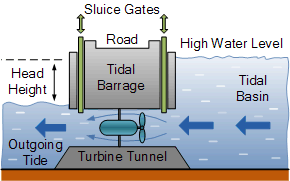
Another type is tidal turbines, which is similar to a wind turbine … but submerged. Since water is denser than air, these turbines can generate more electricity than wind power plants, but it also results in higher manufacturing costs since they need to withstand stronger tides. They can also have a negative affect on marine life, causing the death of animals, emitting noise, and taking up a considerable area of seabed. 4 5
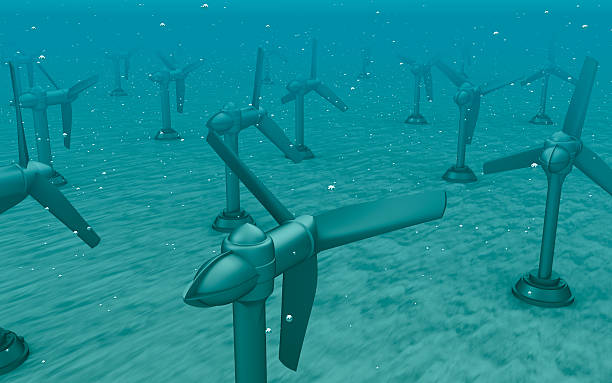
The last type of tidal power is fences, which is like a hybrid between barrages and turbines, but these turbines are positioned in a “fence-like” structure and spin like a turnstile. This type of power plant produces electricity from tidal currents that push the turbine blades, which are attached to a generator. They’re installed entirely underwater, and even though they don’t require large concrete structures like barrages, they can still have a negative affect on marine life. 4 5
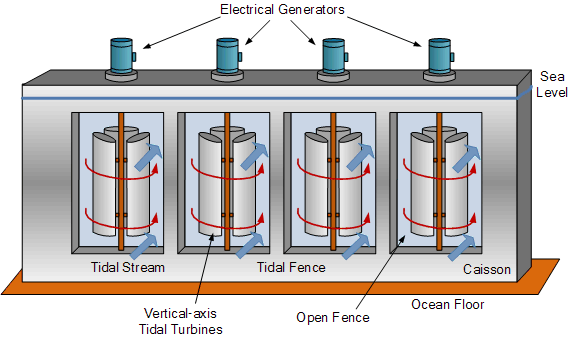
Although tidal power is a renewable, zero carbon emissions, predictable energy source that can produce high power output, just like any other power source it has disadvantages. Currently, there are limited installation sites, it’s expensive, and as I’ve mentioned, it can negatively impact the surrounding ecosystem. But, there are several companies researching and developing new technologies to reduce those problems. 6
The Scottish company Sustainable Marine has developed the PLAT-I (PLATform for Inshore energy) technology, which is an innovative floating tidal energy system. Their PLAT-I 6.40 is equipped with six in-stream turbines that can generate up to 70 kW, which means the entire platform can deliver 420 kW of power, and its modular design allows it to be shipped to any part of the globe with easy assembly on site. An onboard transformer steps up the voltage before it flows out of the platform towards the shore station through a subsea cable. 7
The company is going to be testing the platform in the Bay of Fundy’s Grand Passage (FORCE) site as part of the first phase of the Pempa’q In-Stream Tidal Energy Project, which will produce up to 9MW of electricity to the Nova Scotia grid. The goal is to reduce 17,000 tons of CO2 equivalents annually and power approximately 3,000 homes. 8

A similar approach has been developed by Orbital Marine Power, which launched its 2MW floating tidal turbine, the Orbital O2, in April 2021. This platform has twin 20-meter (65.6-ft) rotors on the ends of 18-meter-long (60-ft) articulating arms, which means sweeping more than 600 square meters (6,460 sq ft) of area below the surface. Anchors can moor it in powerful tidal streams or river currents, and the underwater blades harness the energy from tides. The platform can generate clean, predictable electricity to meet the demand of around 2,000 UK homes and offset approximately 2,200 tons of CO2 equivalent production per year. The most interesting part is that it can be launched like a ship and float out to its location to be moored, commissioned and connected to the grid. 9 10
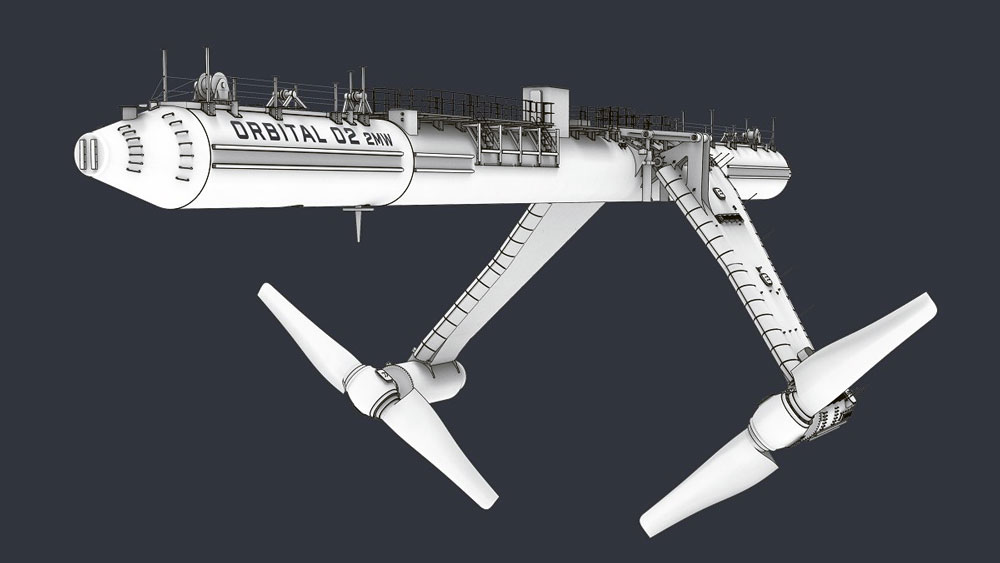
This 680-tonne power house was assembled at the Port of Dundee for past 18 months. Orbital Marine Power chief executive Andrew Scott said:
“We’ve been developing this technology here in the UK for over 15 years.” 11
Orbital estimates an LCOE for its first 2MW O2 turbine of under £200/MWh. This isn’t far from government investment contracts supporting over 3 GW of installed offshore wind capacity in U.K. waters, which range from £165/MWh to £180/MWh. 12
The turbine arrived in Orkney Waters on April 24 and is now being prepared for installation at the European Marine Energy Centre (EMEC). This the third Orbital turbine that EMEC will be testing, but the O2 is first one that is a commercial demonstrator plant. If this works out, they’ll be moving to commercial sales of the technology. 13
Orbital claims the design as “the most powerful tidal turbine in the world”, but it turns out that another particular design can also produce a great amount of power. 10
The undulating membrane produced by EEL energy can provide up to 5MW of clean, renewable energy. It’s something that kind of looks like a whales tail swimming underwater. In this case, energy is converted all over the membrane surface. It undulates as fluid flows through it, generating a periodic motion converted into electricity by an electromechanical system. It also uses a monitoring loop to boost energy conversion as the flow and power change during operation. 14

The benefits of this design are a low drag force, reduced dimensions compared to the power it can deliver, and it automatically orientates itself and is able to capture 100% of the current. And the minimum area required for installation is 10 times smaller than wind turbines. One downside, it sounds like it’s still a ways out for production. Prototype tests for industrial production were scheduled for 2020, but there’s no new information.14
Jumping over to another exciting alternative, what about a kite that generates electricity by flying underwater? Yep … sounds a little weird, but it’s real. The concept of the Deep Green ocean energy power plant, which was patented by Minesto, is something that I don’t think most people would have come up with. Unlike any of the other tidal turbines, this one has wings that push the turbine through the water in a figure eight-shaped pattern, covering a large area at a relative speed that is several times faster than the actual speed of the underwater current. This makes it a great alternative to harness low-flow tidal streams and ocean currents … but how does it actually work?
The wing uses the hydrodynamic lifting force created by the underwater current to move the kite. An onboard control system and rudders steer the kite autonomously in that figure eight trajectory, pushing the turbine through the water. Since the power produced by this unusual power plant has a cubic relationship to its velocity, speeding up the turbine makes the generated electricity several hundred times greater compared to if it was stationary.
The turbine is connected to a generator that provides electricity through a power cable in the tether. Then, a seabed power cable transfers the electricity to the onshore station. 15
The company has two product lines to provide some flexibility. The Deep Green Microgrid focuses on project developers, island economies, and aquaculture developers. It’s geared more towards remote users. It has a rated power from 50 to 250 KW, weighs between 1 to 3 tons with wings that range between 4 to 6 meters, and the depth of installation is lower than 60 meters. Minesto also offers the Deep Green Utility, which focuses on customers like utilities, project developers, and power producers. This is a more powerful tidal power plant that can produce from 500 KW to 3 MW, and weighs between 10 to 35 tons, with wings between 12 to 24 meters, and is also installed deeper than 60 meters.
According to the company, Deep Green is the only known technology to cost-effectively produce electricity at sites with speeds between 1.2–2.4 meters per second and depths of more than 60 meters. And it’s small size is a potential advantage, since it’s up to 15 times less per MW than competing technologies. 15
In October 2020, Minesto installed its first 100kW DG100 tidal kite system in Vestmannasund, a strait in the North West part of Faroe Islands. Minesto has been granted public funding totaling approximately €3.5 million by the EU’s EIC Accelerator and the Swedish Energy Agency for the development of the project. The system has been delivering power to the grid since December 2020. 16
They’ve also started to develop and build the Holyhead Deep site, in North Wales. Once fully installed, a 10MW Deep Green array will produce local and clean electricity with the equivalent of more than 8,000 Welsh households. They plan to increase the site to deliver 80MW, which would increase that figure to almost 70,000 households.17
But how much does it cost? According to the company, Minesto’s LCOE will fall to €100/MWh after 100MW of installed capacity in tidal streams. 18
Although the market of tidal energy is still small compared other renewables, the global market for Wave and Tidal Energy was estimated at US$542.8 Million in 2020, and it’s projected to reach US$5.1 Billion by 2027, which is a growth rate of 37.7% (CAGR). This growth can come with the technology advancement, government grants, as well as green policies. For example, in September 2020, Canada announced a $9.4-million investment in four tidal energy projects to install green energy technologies to the Atlantic region. 19 20
The development of tidal power can also contribute to other carbon-free technologies. For example, electrical vehicles on the island of Yell in Shetland, Scotland, can now be charged entirely by Nova Innovation’s tidal turbines. These turbines have been powering homes and businesses in Shetland for more than five years, and now the island’s vehicles can be powered purely by the tide.
Although tidal energy has been stepping up slowly compared to solar and wind, it’s evident that this power source can have great potential. A kite that generates power from low-flow tides, an undulating membrane that can produce up to 5MW, and huge tidal power platforms are just a few examples of what could come.
- History of Tidal Power ↩︎
- A Brief History of Tidal ↩︎
- Tidal Energy – Technology brief ↩︎
- How does tidal power work? ↩︎
- The Disadvantages of Tidal Power ↩︎
- Tidal energy pros and cons ↩︎
- PLAT-I 6.40 ↩︎
- Sustainable Marine launches ‘next-gen’ floating tidal platform ↩︎
- Orbital Marine Power Launches O2 “World’s Most Powerful Tidal Turbine” ↩︎
- Orbital Marine – Technology ↩︎
- ‘World’s most powerful’ tidal turbine sets sail from Dundee ↩︎
- Demystifying the Cost of Tidal Energy ↩︎
- UPDATE – Orbital’s O2 tidal turbine arrives at EMEC ↩︎
- The EEL Tidal Energy Converter ↩︎
- Minesto – Our Technology ↩︎
- Minesto reaches historic milestone – delivers first tidal energy to the Faroese grid ↩︎
- Underwater Kites… And The World’s First Low Flow Tidal Stream Project ↩︎
- LCOE – Minesto ↩︎
- $542.8 Million Worldwide Wave and Tidal Energy Industry to 2027 – Impact of COVID-19 on the Market ↩︎
- Government Invests in Canada’s Tidal Power Industry ↩︎









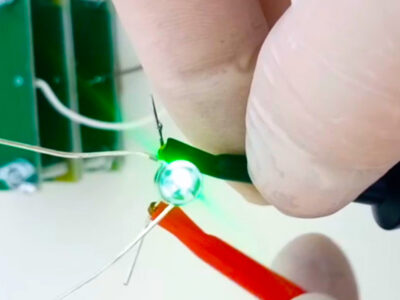





Comments